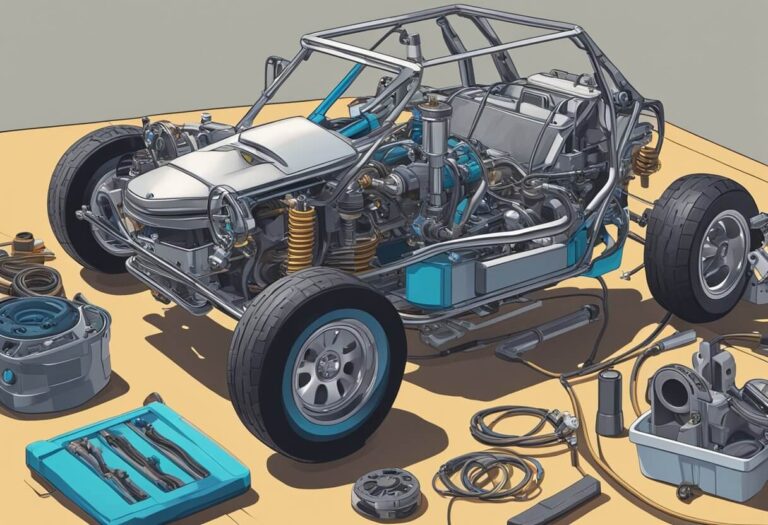Dune Buggy with Honda Civic Motor: The Ultimate Off-Roading Machine
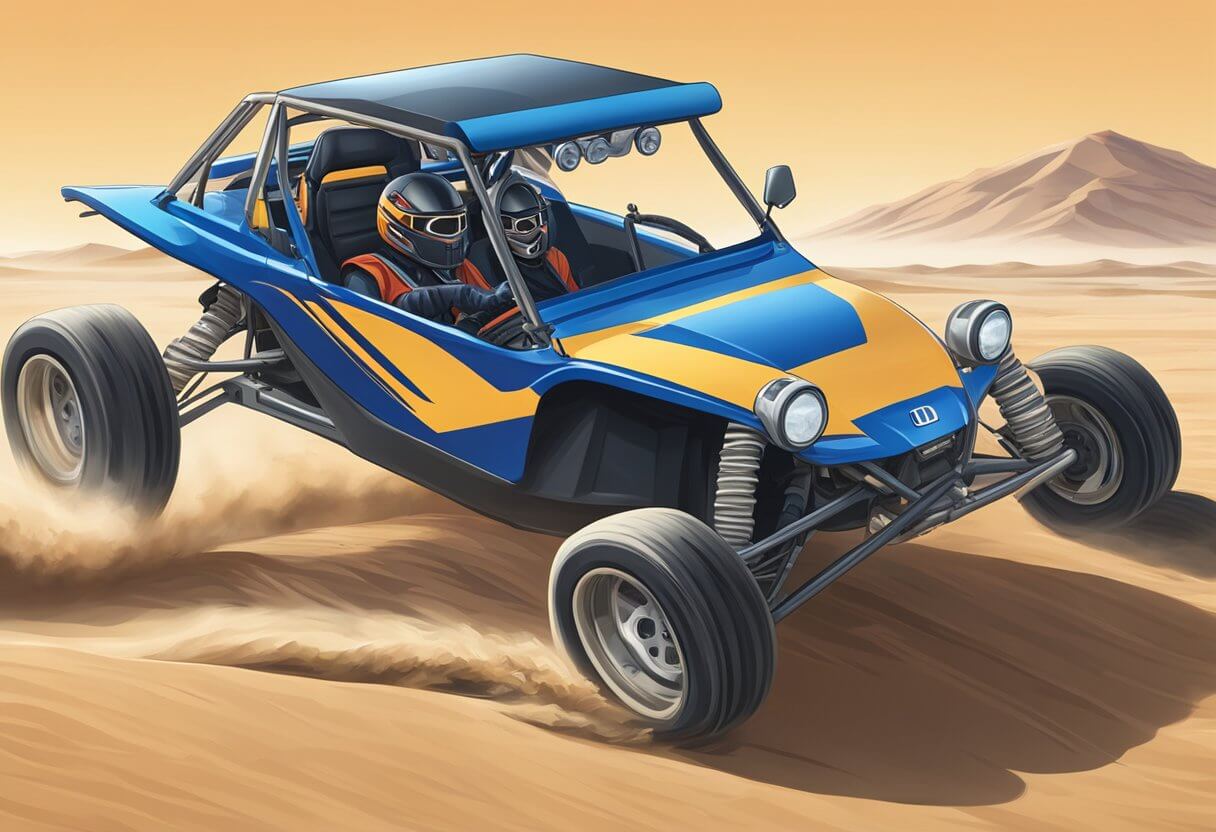
Dune buggies are off-road vehicles that are designed to be driven on sand dunes, beaches, and other types of rough terrain. These vehicles are typically lightweight, have an open frame, and are powered by a high-performance engine. One popular engine choice for dune buggies is the Honda Civic motor.
The Honda Civic motor is a compact and reliable engine that is capable of producing a lot of power. When installed in a dune buggy, it can provide the vehicle with the speed and agility needed to navigate through sand dunes and other challenging terrain. Additionally, the Honda Civic motor is known for its fuel efficiency, which can be a major advantage when driving off-road for long periods of time.
Overall, the combination of a dune buggy with a Honda Civic motor can be a winning combination for those who are looking for an exciting and reliable off-road vehicle. With its lightweight frame, powerful engine, and ability to handle challenging terrain, a dune buggy with a Honda Civic motor can provide a thrilling driving experience for those who enjoy off-roading.
Dune Buggy Basics
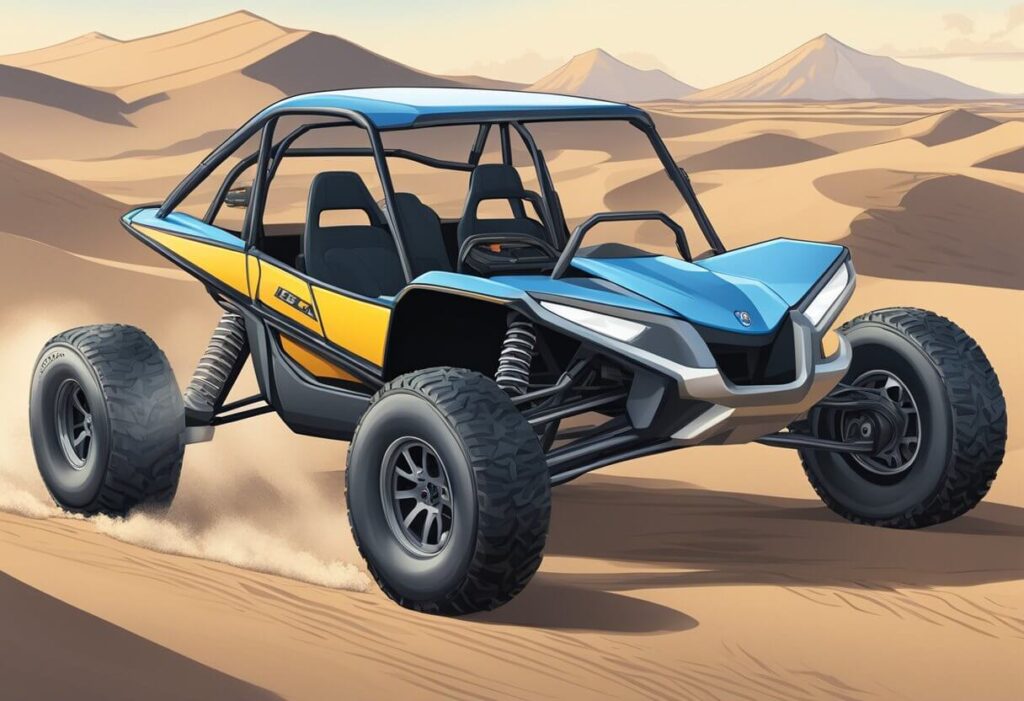
Defining a Dune Buggy
A dune buggy is a lightweight recreational vehicle designed for use on beaches, sand dunes, and other off-road terrains. It is an open-top vehicle with a modified body, usually made of fiberglass, mounted on a VW Beetle chassis. Dune buggies are typically equipped with large, wide tires that provide excellent traction on sand and other loose surfaces.
Honda Civic Motors in Dune Buggies
Honda Civic motors are a popular choice for dune buggy enthusiasts due to their reliability, power, and affordability. The Civic’s four-cylinder engines are known for their high-revving capabilities, making them ideal for off-road use. Additionally, Honda engines are known for their fuel efficiency and low emissions, making them environmentally friendly.
When installing a Honda Civic motor in a dune buggy, it is important to choose the right engine size and transmission. The most common engine size used in dune buggies is the 1.8-liter engine, which provides ample power for off-road use. Additionally, a five-speed manual transmission is typically used to provide the driver with more control over the vehicle.
Building Your Dune Buggy

Choosing the Right Honda Civic Motor
When building a dune buggy with a Honda Civic motor, it is important to choose the right one for your needs. The Honda Civic is a popular choice for dune buggies due to its reliability and availability of parts. However, there are several different models of the Civic, each with its own unique features and specifications.
One popular choice is the Honda Civic Si, which has a high-performance engine and can provide plenty of power for off-road driving. Another option is the Honda Civic Type R, which has even more power and is designed for racing.
Frame and Chassis Modifications
Once you have chosen the right Honda Civic motor for your dune buggy, you will need to modify the frame and chassis to accommodate it. This may involve shortening the chassis or building a new one from scratch. It is important to ensure that the frame and chassis are strong enough to handle the additional weight and power of the Honda Civic motor.
Modifications may also need to be made to the suspension and wheels to ensure that the dune buggy can handle rough terrain. This may include upgrading to larger wheels and tires and adding additional shocks or springs.
Engine Mounting and Integration
Mounting the Honda Civic motor in your dune buggy will require careful planning and execution. The engine will need to be securely mounted to the frame and chassis, and all necessary wiring and plumbing will need to be installed.
The engine must be properly integrated with all other systems of the dune buggies including the steering, brakes and transmission. It may be necessary to upgrade and modify these systems.
Building a dune buggies with a Honda Civic engine can be an exciting and rewarding project. You can build a reliable and powerful off-road vehicle with the right planning.
Performance Enhancements
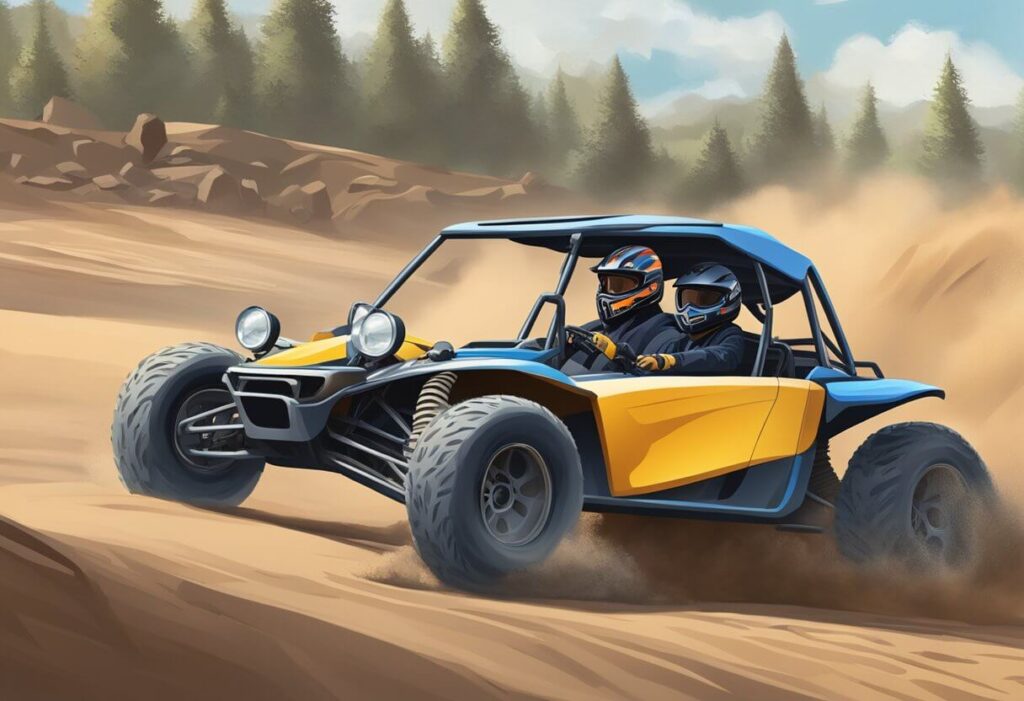
Upgrading Honda Civic Engines
When it comes to upgrading the Honda Civic engine, there are several options available. One popular upgrade is to swap out the stock engine for a more powerful one. The Honda K20A engine, for example, is a popular choice for dune buggies. It is a 2.0-liter engine that produces up to 150-220 horsepower and 131-159 lb-ft of torque. Other popular engine swaps include the B16A and B18C engines.
Another option for upgrading the Honda Civic engine is to install a turbocharger or supercharger. These devices increase the engine’s power output by forcing more air into the combustion chamber. However, it is important to note that installing a turbocharger or supercharger can be complex and expensive.
Suspension and Handling Improvements
To improve the handling of a dune buggy with a Honda Civic engine, it is important to upgrade the suspension. This can be done by installing high-performance shocks and struts, as well as sway bars and other suspension components. This will help to improve the buggy’s stability and handling on rough terrain.
Another option for improving handling is to install a roll cage. This will help to protect the driver and passengers in the event of a rollover, and it will also increase the rigidity of the buggy’s chassis.
Transmission and Drivetrain Adjustments
To get the most out of a dune buggy with a Honda Civic engine, it is important to make adjustments to the transmission and drivetrain. This can be done by installing a high-performance clutch and flywheel, as well as upgrading the transmission with stronger gears and synchros.
Another option for improving the drivetrain is to install a limited-slip differential. This will help to improve traction and reduce wheel spin, which is essential for off-road driving. Additionally, upgrading the brakes with high-performance pads and rotors will help to improve stopping power and reduce brake fade.
Safety and Regulations

Safety Features for Dune Buggies
Dune buggies are designed to be driven off-road, which means they can be exposed to a variety of hazards that are not present on paved roads. As a result, safety features are essential for the safe operation of these vehicles. Some of the safety features that are commonly found on dune buggies include:
- Roll cages: These are designed to protect the driver and passengers in the event of a rollover.
- Seat belts: These are essential for keeping the occupants of the vehicle securely in place during off-road driving.
- Lights: Dune buggies should be equipped with headlights, taillights, and turn signals to ensure visibility on the road.
- Windshield: A windshield is essential for protecting the occupants of the vehicle from debris and other hazards.
Legal Requirements for On-Road Use
Dune buggies are not typically designed for on-road use, but it is possible to make them street legal with the right modifications. However, it is important to note that the legal requirements for on-road use vary from state to state. In general, dune buggies that are intended for on-road use must meet certain requirements, such as:
- Working headlights, taillights, turn signals, and brake lights.
- A horn.
- A windshield.
- Seat belts for all passengers.
It is important to check the specific regulations in your state before attempting to make your dune buggy street legal. Failure to comply with the regulations can result in fines or even the impounding of your vehicle.
Maintenance and Troubleshooting
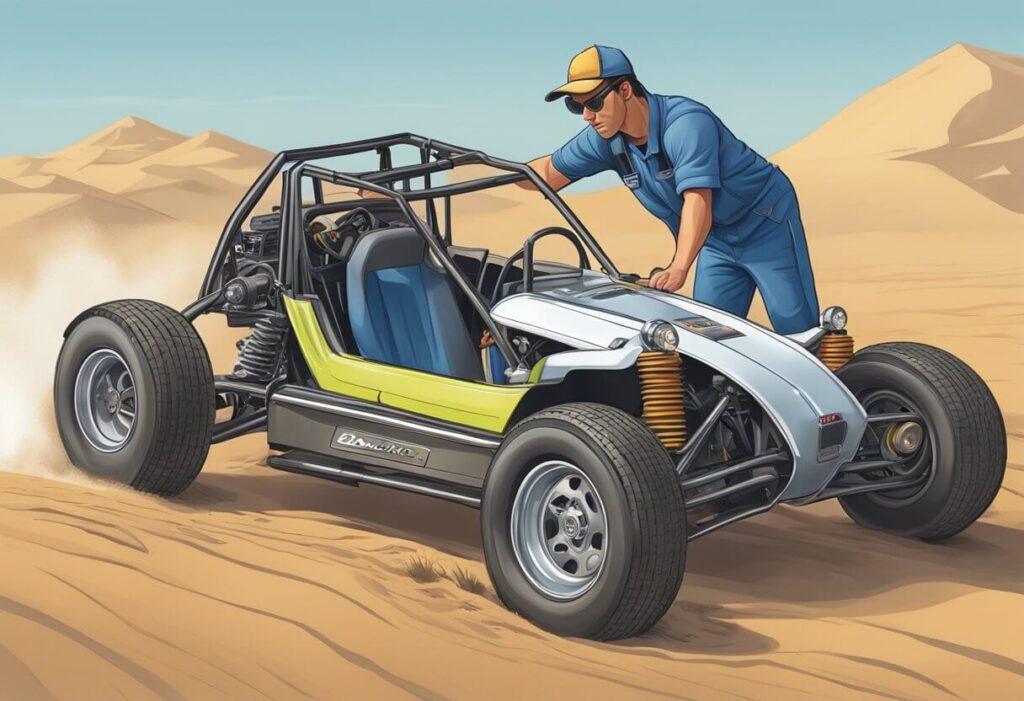
Routine Dune Buggy Maintenance
Regular maintenance is essential for keeping a dune buggy with a Honda Civic motor running smoothly. Here are some maintenance tasks that should be performed regularly:
- Check the oil level and change the oil if necessary.
- Inspect the air filter and clean or replace it if it is dirty.
- Check the spark plugs and replace them if they are worn or damaged.
- Inspect the battery and clean the terminals if they are corroded.
- Check the tires for wear and ensure that they are properly inflated.
- Inspect the brakes and replace the brake pads if they are worn.
By performing these routine maintenance tasks, the driver can ensure that the dune buggy is in good condition and ready for any adventure.
Common Issues with Honda Civic Motors
While Honda Civic motors are generally reliable, there are a few common issues that may arise. Here are some issues to be aware of:
- Overheating: Honda Civic motors may overheat if the cooling system is not functioning properly. This can be caused by a faulty thermostat, a clogged radiator, or a damaged water pump. If the engine is overheating, it should be inspected by a qualified mechanic.
- Oil Leaks: Honda Civic motors may develop oil leaks if the gaskets or seals are worn or damaged. This can result in a loss of oil pressure and engine damage. If an oil leak is detected, it should be repaired as soon as possible.
- Electrical Issues: Honda Civic motors may experience electrical issues if the battery, alternator, or starter is faulty. This can result in problems starting the engine or a loss of power while driving. If an electrical issue is detected, it should be inspected by a qualified mechanic.
By being aware of these common issues and addressing them promptly, the driver can ensure that their dune buggy with a Honda Civic motor remains reliable and fun to drive.
Customization and Accessories

Exterior Customization Options
One of the best things about owning a dune buggy is the ability to customize its exterior to your liking. There are many options available to make your buggy stand out from the crowd. Some popular exterior customization options include:
- Custom paint jobs: A custom paint job can completely transform the look of your dune buggy. You can choose from a variety of colors and designs to make your buggy truly unique.
- Graphics and decals: Graphics and decals can add an extra element of style to your dune buggy. You can choose from a wide range of designs, including flames, stripes, and custom logos.
- Lighting upgrades: Upgrading your dune buggy’s lighting can not only improve its appearance but also its safety. LED light bars and accent lighting can make your buggy look great while also providing better visibility on the trail.
Interior Enhancements
While the exterior of your dune buggy is important, the interior is where you’ll be spending most of your time. There are many ways to enhance the comfort and functionality of your dune buggy’s interior, including:
- Custom seats: Upgrading your dune buggy’s seats can make a big difference in your comfort level on the trail. You can choose from a variety of materials and designs to find the perfect seats for your needs.
- Sound systems: Adding a sound system to your dune buggy can make your rides more enjoyable. You can choose from a variety of speakers and head units to create the perfect audio experience.
- Storage solutions: Dune buggies don’t have a lot of storage space, but there are ways to maximize the space you do have. Adding storage boxes or bags can help you keep your gear organized and easily accessible.
Performance Accessories
If you’re looking to improve the performance of your dune buggy, there are many accessories available to help you achieve your goals. Some popular performance accessories include:
- Engine upgrades: Swapping out your dune buggy’s engine for a more powerful one can greatly improve its performance. A Honda Civic motor is a popular choice for dune buggy enthusiasts due to its reliability and power.
- Suspension upgrades: Upgrading your dune buggy’s suspension can improve its handling and stability on the trail. You can choose from a variety of shocks and springs to find the perfect combination for your needs.
- Tires and wheels: Upgrading your dune buggy’s tires and wheels can improve its traction and overall performance. You can choose from a variety of tire types and wheel designs to find the perfect combination for your needs.
Overall, there are many customization and accessory options available for dune buggy enthusiasts. Whether you’re looking to improve the appearance, comfort, or performance of your dune buggy, there are plenty of options to choose from.
Frequently Asked Questions
What are the advantages of using a Honda Civic motor in a dune buggy?
Using a Honda Civic motor in a dune buggy provides several advantages. First and foremost, Honda Civic motors are known for their reliability and fuel efficiency, which makes them an excellent choice for off-road vehicles. Additionally, Honda Civic motors are relatively easy to find and affordable to purchase, making them an attractive option for those on a budget.
How does a Honda Civic motor compare to other engines commonly used in dune buggies?
Compared to other engines commonly used in dune buggies, such as Volkswagen Beetle engines, Honda Civic motors offer several advantages. For one, Honda Civic motors are more modern and efficient, meaning they produce more power while using less fuel. Additionally, Honda Civic motors are easier to find and purchase, making them a more convenient option for those looking to build a dune buggy.
What are the typical costs associated with installing a Honda Civic motor into a dune buggy?
The cost of installing a Honda Civic motor into a dune buggy can vary depending on several factors, including the condition of the motor, the type of dune buggy being built, and the skill level of the builder. However, on average, the cost of installing a Honda Civic motor into a dune buggy can range from $2,000 to $5,000.
Are there specific models of Honda Civic motors that are preferred for dune buggy conversions?
While there are several models of Honda Civic motors that can be used for dune buggy conversions, some are more preferred than others. The Honda Civic D16Z6, for example, is a popular choice due to its high power output and reliability. Other popular options include the Honda Civic B16A and the Honda Civic K20A.
Where can one find a dune buggy kit compatible with a Honda Civic motor?
There are several companies that offer dune buggy kits that are compatible with Honda Civic motors. Some popular options include Manx Dune Buggy Kits, Berrien Buggy Kits, and Meyers Manx Kits. It is also possible to find custom-built kits online or through local dune buggy builders.
What modifications are usually needed to fit a Honda Civic motor into a dune buggy?
To fit a Honda Civic motor into a dune buggy, several modifications are typically needed. These can include modifying the engine mount, installing a new transmission, and upgrading the exhaust system. Additionally, the electrical system may need to be modified to accommodate the new engine, and the cooling system may need to be upgraded to ensure proper engine temperature regulation.

